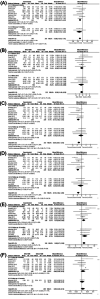Impact of renal denervation on cardiac remodeling in resistant hypertension: A meta-analysis
- PMID: 38402531
- PMCID: PMC10823454
- DOI: 10.1002/clc.24222
Impact of renal denervation on cardiac remodeling in resistant hypertension: A meta-analysis
Abstract
Twelve studies involving 433 patients were included. After RDN treatment, LVMI decreased by 13.08 g/m2 (95% confidence interval [CI]: -18.38, -7.78; p < .00001), PWTd decreased by 0.60 mm (95% CI: -0.87, -0.34; p < .00001), IVSTd decreased by 0.78 mm (95% CI: -1.06, -0.49; p < .00001), and LVEF increased by 1.80% (95% CI: 0.71, 2.90; p = .001). However, there were no statistically significant improvements in LVIDd (95% CI: -1.40, 0.24; p = .17) and diastolic function (E/A) (95% CI: -0.04, 0.14; p = .28). Drug treatment for resistant hypertension (RH) is challenging. Renal denervation (RDN) is one of the most promising treatments for RH. Although studies have shown RDN can control blood pressure, the impacts of RDN on cardiac remodeling and cardiac function are unclear. This meta-analysis evaluated the effect of RDN on cardiac structure and function in patients with RH. PubMed, Embase, and Cochrane were used to conduct a systematic search. The main inclusion criteria were studies on patients with RH who received RDN and reported the changes in echocardiographic parameters before and after RDN. Echocardiographic parameters included left ventricular mass index (LVMI), end-diastolic left ventricular internal dimension (LVIDd), left ventricular end-diastolic posterior wall thickness (PWTd), end-diastolic interventricular septum thickness (IVSTd), E/A, and left ventricular ejection fraction (LVEF). Data was analyzed using RevMan. Twelve studies involving 433 patients were included. After RDN treatment, LVMI decreased by 13.08g/m2 (95%confidence interval [CI]: -18.38, -7.78, p < .00001), PWTd decreased by 0.60mm (95% CI: -0.87, -0.34, p < 0.00001), IVSTd decreased by 0.78mm (95% CI: -1.06, -0.49, p < .00001), and LVEF increased by 1.80% (95% CI: 0.71, 2.90, p = .001). However, there were no statistically significant improvements in LVIDd (95% CI: -1.40, 0.24, p = .17) and diastolic function (E/A) (95% CI: -0.04, 0.14, p =.28). This meta-analysis finds that RDN can improve left ventricular hypertrophy and ejection fraction in patients with RH but has no significant effect on LVIDd and diastolic function. However, more studies are warranted due to the lack of a strict control group, a limited sample size, and research heterogeneity.
Keywords: cardiac remodeling; renal denervation; resistant hypertension.
© 2024 The Authors. Clinical Cardiology published by Wiley Periodicals, LLC.
Conflict of interest statement
The authors declare no conflict of interest.
Figures



Similar articles
-
Reductions of left ventricular mass and atrial size following renal denervation: a meta-analysis.Clin Res Cardiol. 2016 Aug;105(8):648-656. doi: 10.1007/s00392-016-0964-2. Epub 2016 Feb 2. Clin Res Cardiol. 2016. PMID: 26838292 Review.
-
Effects of Renal Denervation on Cardiac Remodeling, Cardiac Function, and Cardiovascular Neurohormones in Heart Failure with Reduced Ejection Fraction Patients: A Meta-Analysis and Systematic Review.Cardiorenal Med. 2025;15(1):261-280. doi: 10.1159/000545078. Epub 2025 Mar 25. Cardiorenal Med. 2025. PMID: 40132560
-
Renal denervation decreases susceptibility of the heart to ventricular fibrillation in a canine model of chronic kidney disease.Exp Physiol. 2017 Nov 1;102(11):1414-1423. doi: 10.1113/EP086370. Epub 2017 Oct 4. Exp Physiol. 2017. PMID: 28833735
-
Effect of renal denervation on left ventricular mass and function in patients with resistant hypertension: data from a multi-centre cardiovascular magnetic resonance imaging trial.Eur Heart J. 2014 Sep 1;35(33):2224-31b. doi: 10.1093/eurheartj/ehu093. Epub 2014 Mar 6. Eur Heart J. 2014. PMID: 24603307 Clinical Trial.
-
Impact of renal sympathetic denervation on cardiac magnetic resonance-derived cardiac indices in hypertensive patients - A meta-analysis.J Cardiol. 2021 Oct;78(4):314-321. doi: 10.1016/j.jjcc.2021.05.002. Epub 2021 Jun 1. J Cardiol. 2021. PMID: 34088560
Cited by
-
Progress in diagnosis and treatment of hypertension combined with left ventricular hypertrophy.Ann Med. 2024 Dec;56(1):2405080. doi: 10.1080/07853890.2024.2405080. Epub 2024 Sep 20. Ann Med. 2024. PMID: 39301864 Free PMC article. Review.
-
Blood Pressure Control and Clinical Outcomes After Renal Denervation Through Irrigated Catheter Radiofrequency Ablation in Patients with Resistant Hypertension: A Case Series with Up to 10 Years of Follow-Up.High Blood Press Cardiovasc Prev. 2024 Nov;31(6):687-694. doi: 10.1007/s40292-024-00685-7. Epub 2024 Nov 18. High Blood Press Cardiovasc Prev. 2024. PMID: 39557771
References
-
- Calhoun DA, Jones D, Textor S, et al. Resistant hypertension: diagnosis, evaluation, and treatment: a scientific statement from the American Heart Association Professional Education Committee of the Council for High Blood Pressure Research. Circulation. 2008;117(25):e510‐e526. - PubMed
-
- Myat A, Redwood SR, Qureshi AC, Spertus JA, Williams B. Resistant hypertension. BMJ. 2012;345:e7473. - PubMed
-
- Muiesan ML, Salvetti M, Rizzoni D, et al. Resistant hypertension and target organ damage. Hypertens Res. 2013;36(6):485‐491. - PubMed
-
- Cuspidi C, Vaccarella A, Negri F, Sala C. Resistant hypertension and left ventricular hypertrophy: an overview. J Am Soc Hypertens. 2010;4(6):319‐324. - PubMed
Publication types
MeSH terms
LinkOut - more resources
Full Text Sources
Medical

